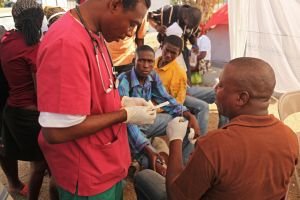Blog post
Ebola and ‘other’ infectious diseases: read all about it?
‘New Ebola outbreak declared in DRC’
‘Universal influenza vaccine trial begins’
'African scientists call for more control of their continent’s genomic data’
These were just three of the stories I circulated to members of our working group on research in global health emergencies at the end of May, as part of a ‘news gathering’ exercise to help ensure that they’re kept up-to-date on issues relevant to our project.
As an end-of-the-month ‘treat’, working group members receive a collection of links to forthcoming conferences, new blogs, and recently-published journal articles. But the bulk of the list comprises news articles.
Whilst collating news stories for the May edition, my head was turned almost constantly by the plethora of news articles concerning the current Ebola outbreak in the Democratic Republic of the Congo (DRC). Our working group members subsequently received a hefty document in their inboxes, with 33 links to various updates on Ebola in the DRC – and those were only a selection of the pieces on Ebola I located that month.
Job done, I thought. But then I had a nudge from one of our working group members to highlight an infectious disease that had emerged in Kerala in India, but hadn’t made it into my update: the Nipah virus infection (NiV).
NiV is a particularly nasty disease: the WHO’s regional office in south-east Asia reported earlier this month that out of 18 confirmed cases in Kerala, 17 people died from the virus. There are no specific treatments or vaccines available, and therefore the primary treatment for people who contract NiV is supportive care to treat severe respiratory and neurologic complications.
But despite the lack of treatment options and the high mortality rate observed in Kerala (a similarly high mortality rate was observed in the 2013 outbreak of NiV in Bangladesh, where 24 cases were confirmed, 21 of whom died), the outbreak did not hit the headlines in the same way as the Ebola outbreak did, as evidenced – at a micro-level – by its omission from the news alerts I receive on a daily basis.
Now, perhaps I need to adjust my news alert settings (I probably do); but part of the reason for the relatively low level of news coverage on this outbreak might be due to the fact that so much of the ‘space’ for ‘infectious disease news’ – particularly in UK media coverage – was ‘taken up’ by reporting the Ebola outbreak in DRC. (Unsurprisingly, far more coverage of NiV was provided by the Indian media.) In UK reporting, perhaps there’s just no room for more than one ‘big story’ on infectious disease outbreaks; or perhaps the devastation wreaked by the 2014-15 Ebola outbreak in West Africa is still at the forefront of editors’ minds.
What does seem clear is that, over the past month, even the most cursory reader of health-related news could not fail to miss the surfeit of stories about the current outbreak of Ebola in the DRC. But it would take a more in-depth search to locate the same number and breadth of pieces on the NiV outbreak in Kerala.
Whatever the reasons that some infectious diseases being are reported more actively by the media than others, the lesson I learnt when reviewing the news update I produced at the end of May is to have a good think about the geographical range of my sources, and to expand my searches beyond western European newsrooms.
When different infectious disease outbreaks emerge at the same time in the future, it will be interesting to observe, and to think further about, which get the top billing, and to work out why they do. A good test might be any future flu outbreaks: on 15 June, the top story on the Telegraph’s website focused on an interview with the deputy chief medical officer for England, Professor Jonathan Van-Tam, who suggested that “the most likely candidate to spark a worldwide flu pandemic” is H7N9, an avian influenza virus currently circulating in bird populations in China. How would the media triage this story, if another infectious disease outbreak occurred concurrently?
This issue will be at the forefront of our minds as we launch our call for evidence on research in global health emergencies this week. What makes one infectious disease take the headlines, and another make the small print? We’ll await to see if respondents to our call for evidence think it’s all about Ebola too.


Comments (1)
Brian Scott
Thank you for your interesting note.
From my experience of working with the media, as ceo of Oxfam Ireland, they can be quite arbitrary about what they feature. Usually what does get the coverage has been driven by the work of a particular interest, whether a charity, company, government, or other (many journalists are quite lazy!). We at Oxfam certainly worked hard to push our stories of poverty, human rights, disasters, etc.
As current chair of the Meningitis Research Foundation(MRF), I can add to your list of overlooked infectious disease outbreaks, the sometimes enormous numbers of deaths due to Meningitis A in the Meningitis Belt - up to 25,000 a few years ago, with nary a note in the UK press. The recently completed five-year vaccination campaign has transformed the situation for Men A, but earlier this year more than 1,000 people died of another meningitis strain in northern Nigeria.
Control of genomic data is very important. A few years ago we at MRF sponsored the creation of a genome library for meningitis strains from within the UK and Ireland - it's housed at the Sanger Institute. As part of our plan to defeat meningitis globally by 2030, under the aegis of the SDGs (this initiative is led by WHO, with the steering support of CDC, LSHTH, PATH, and ourselves) we are planning to expand the library globally. A few African strains have already found their way into the library via a mobile MRF sponsored last year in Burkino Faso in support of another meningitis outbreak. But we hope to garner samples ultimately from all over the world, as a means of rapidly identifying strains and contributing to a range of research. The library is open to all - just google meningitis genome library.
Join the conversation